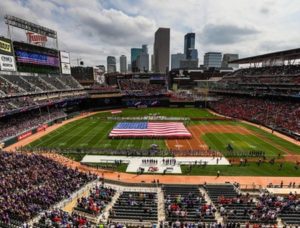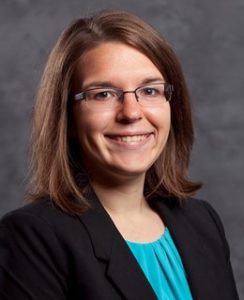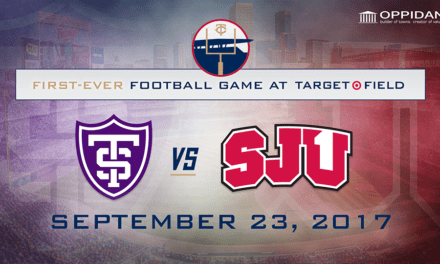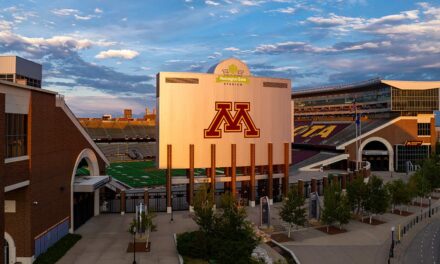The Tommies beat the Johnnies on the gridiron Saturday at Target Field, but both St. Thomas and St. John’s – along with perhaps the entire Minnesota Intercollegiate

Target Field hosted Saturday’s St. John’s/St. Thomas football rivalry, to high acclaim
Athletic Conference – came out as winners in the bigger picture.
A record Division III crowd of 37,355 attended the first football game hosted at the Minnesota Twins’ baseball park, but the game got the attention of Sports Illustrated and ESPN’s College GameDay. It also made a big splash on social media.
“The entire event was a huge success, not just for the two teams involved, but for the conference and, I believe, for Minnesota football and small college football,” says Dan McKane, executive director of the MIAC conference. “It did a lot to shine a light on small college football that normally isn’t there. That’s really good. People are going to be talking about this for years to come. … This is something we are going to be able to hang our hat on for quite a bit of time.”
Possible enhancements going forward?
Michelle Morgan, associate athletic director for St. Thomas, was the school’s point person in planning the big game. She told MNSBB Monday that while fans down the third-base line were probably hotter than they’d have preferred due to unseasonably warm September weather, there wasn’t much she would change about how Saturday went.
“I can’t control that,” she says. “All the things we could control were successful. The attention to detail on our part and on the Twins’ part made the difference between a good event and a great event.”
She’s been working on planning for the game for about a year and she credited the collaboration between the Twins and the two schools for pulling it off.
“Overall, I would say it was a fantastic experience,” she says.

Michelle Morgan, St. Thomas Athletic Department
She says the school will take a short period to bask in the successful event before beginning discussions on enhancements or improvements that could be made in hosting another game at Target Field.
The St. Thomas athletic department staff is still working on culling hard data on how much of an impact the game’s visibility had on the institution and the conference. Subjectively, she adds, it was a great showcase.
“There sometimes is a stigma with Division III athletics,” she says. “We had an opportunity to show the country, to show the world, really, that these are scholar athletes first. They are not on scholarship. They chose St. Thomas and St. John’s for the education first and the athletics second. And the fact that it can be a really competitive game and that a lot of people are willing to come and be a part of it, that was pretty amazing and pretty special. Honestly, it’s going to be pretty hard to replicate that.”
St. John’s ended up on the short end of a 20-17 score on Saturday, but Johnnies’ officials were also proud to take part in the game and pleased with the overall event. Nicci Malecha, athletic facilities coordinator at St. John’s, says there were some differences between traveling to this game and heading to a more traditionally hosted road game.
Coordinating ticket sales for students at St. John’s is atypical for a road game, she says. Navigating the issues of locker room set up, arriving in buses and getting players on and off the field were a bit trickier than when playing at a normal-sized, familiar venue. But they were not major problems.
“There was a little bit more that went into it than a standard away game would entail,” she says.
Her biggest feedback: student tickets were assigned seating where they typically would have been general admission. Those fans may have spent more at concessions stands if the seats were GA because they would have wanted to arrive earlier to get prime seats close to the front of their section, Malecha says.
“In the end, it turned out to be a general student section,” she says. “They went to sit with their friends regardless once they got into their area. Putting that straightforward from the beginning would have solved any headaches.”
Overall, Malecha echoed the sentiments of her counterpart at St. Thomas who felt it was a successful event that drew tremendous visibility

Nicci Malecha, St. John’s Athletic Department
for the institutions and the conference.
“I know the outcome wasn’t in our favor, but it was a cool atmosphere for hosting a football game,” she says. “It was just such a neat experience for all the players and both institutions to be a part of this game.”
Future MIAC games at Target Field?
The MIAC’s McKane says he was “blown away” by the event. He believes the high-profile game showcased the skill level of those who play in the MIAC and the enthusiasm that exists for its schools.
He says he’d encourage – though not mandate – any of the conference’s schools to try to host a game at Target Field or other visible venues, though he acknowledges that not every school is going to want to take a game off campus.
In the early days of the Metrodome, the MIAC played its final week’s games there in a similar showcasing effort. That ended in the early 2000s, however, as teams began putting resources into improving their on-campus athletic facilities. Ultimately, McKane says he’d defer that decision to the schools.
“We’ll encourage our membership to think about it,” he says. “The schools have to balance that to see if it’s worth it. But for the exposure we saw Saturday, definitely. I can’t tell anyone to move their games to a bigger venue, but certainly would work with them on it.”
Malecha says St. John’s enjoyed playing at Target Field, but probably wouldn’t seek to relocate a home game. The school can seat 20,000 people at its stadium in Collegeville and likes the atmosphere it can create on campus.
Morgan says she’d like to take some time to breathe after working for a year to pull this first game together, but adds that St. Thomas would be open to playing another game at Target Field or elsewhere.
“We would do it again in a heartbeat,” she says.
Twins’ perspective on the future of football at Target Field
The Twins’ St. Peter says the team is thrilled on how its first foray into football went.
“The initial impression was that it was a really solid first effort for football,” he says. “The energy, the atmosphere was electric. Both teams really seemed to embrace the experience. The fans obviously really enjoyed the venue and the players, I think, thought the playing surface was good.”
St. Peter says the team will have in depth discussions with St. John’s and St. Thomas officials over the next few weeks to further discuss what went well and what could improve.
He’s also monitoring the game’s impact on the Target Field turf. He gave props to Head Groundskeeper Larry DiVito and his staff for getting the field ready to host football, but adds that he’ll seek feedback from Twins players and staff to see how the playing field bounces back for the Twins, who close out their upstart regular season with three games starting Friday, Sept. 29.
“We’re never going to do anything that places our games or our players at any level of risk,” St. Peter says.
There will be no football at Target Field in 2018. The park will host a game August 31, 2019 between North Dakota State and Butler.
St. Peter adds that in the future, it may make sense to consider playing football at Target Field in November, because the Twins’ season will be done. That would allow for fully sodding the infield.
“That would give us the best chance to have the best field,” he adds.





Recent Comments